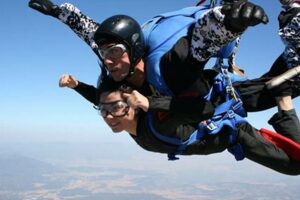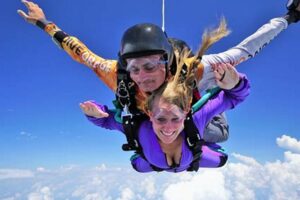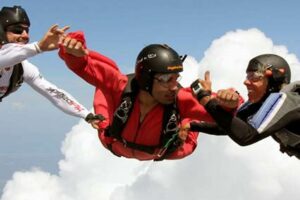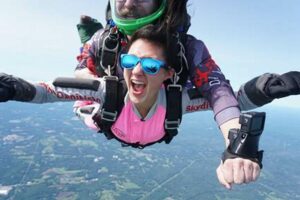Table of Contents
Base jumping and skydiving, while sharing similarities, are distinct aerial sports. Base jumping involves leaping from a fixed structure, such as a bridge, cliff, or building, while skydiving involves jumping from an aircraft.
Both activities offer adrenaline rushes and breathtaking views, but differ in their levels of risk, technique, and regulations. Base jumping poses greater inherent danger as it involves lower altitudes and less time for deployment.
This article will delve into the nuances of base jumping versus skydiving, exploring their safety protocols, equipment requirements, and the unique thrill each one provides.
Base Jumping vs Skydiving
Understanding the nuances of base jumping versus skydiving requires exploring key aspects that define these activities and differentiate their experiences. These aspects encompass:
- Altitude
- Equipment
- Risk
- Legality
- Training
- Community
- Adrenaline
- Skill
- Preparation
Each aspect plays a crucial role in shaping the nature and experience of base jumping and skydiving. Altitude, for instance, influences the time available for deployment and the level of skill required. Equipment, ranging from suits to parachutes, ensures safety and influences maneuverability. The legality of these activities varies across regions, impacting accessibility and regulations. Training and preparation are paramount, as they determine the jumper’s proficiency and readiness. The sense of community, shared passion, and camaraderie among jumpers add to the overall experience. Ultimately, understanding these aspects provides a comprehensive view of what differentiates base jumping from skydiving and allows for informed decision-making.
Altitude
In the realm of base jumping versus skydiving, altitude stands as a defining factor, influencing both the nature of the jump and the skills required to execute it successfully. Unlike skydiving, where jumpers typically exit an aircraft at altitudes of several thousand feet, base jumpers launch themselves from much lower elevations, typically ranging from a few hundred to a few thousand feet.
This difference in altitude has a profound impact on the experience. With less altitude, base jumpers have a shorter amount of time to deploy their parachutes, requiring quicker decision-making and more precise maneuvers. The lower altitude also intensifies the sense of proximity to the ground, adding an extra layer of adrenaline and exhilaration.
Despite the inherent challenges, altitude plays a crucial role in distinguishing base jumping from skydiving. It demands a higher level of skill and experience, as jumpers must be able to assess the risks and execute their jumps with extreme precision. The lower altitude also requires specialized equipment, such as smaller parachutes and wingsuits, designed for rapid deployment and maneuverability in confined spaces.
Understanding the connection between altitude and base jumping versus skydiving is essential for anyone considering these activities. It underscores the importance of proper training, meticulous planning, and a deep understanding of the risks involved. By respecting the demands of altitude, jumpers can push their limits while prioritizing safety and maximizing the thrill of the experience.
Equipment
In the realm of base jumping versus skydiving, equipment plays a pivotal role, influencing not just the safety but also the nature and capabilities of each activity. For base jumpers, the gear serves as a lifeline, enabling them to leap from towering structures and navigate the complexities of urban environments or rugged terrain. Skydivers, on the other hand, rely on their equipment to ensure a safe and controlled descent from aircraft at much higher altitudes.
The most critical piece of equipment for both base jumpers and skydivers is the parachute, responsible for providing a safe and controlled descent. Base jumpers typically use smaller, more agile parachutes designed for rapid deployment at low altitudes. Skydivers, on the other hand, often opt for larger, more stable parachutes that offer greater maneuverability at higher altitudes. Other essential gear includes jumpsuits, helmets, and altimeters, which provide protection, communication, and vital information during the jump.
Beyond the essential equipment, base jumpers and skydivers may also use specialized gear to enhance their experiences or suit their individual needs. Base jumpers, for instance, might use wingsuits to increase their speed and maneuverability, while skydivers might opt for camera rigs to capture their jumps from unique perspectives. The choice of equipment ultimately depends on the jumper’s skill level, the jump’s intended purpose, and the specific environment in which they will be jumping.
Understanding the connection between equipment and base jumping versus skydiving is crucial for ensuring safety and maximizing the enjoyment of these activities. By carefully selecting and maintaining their equipment, jumpers can mitigate risks, enhance their performance, and push the boundaries of these thrilling sports.
Risk
In the realm of base jumping versus skydiving, risk stands as an omnipresent factor, shaping the nature of these activities and demanding the utmost respect from participants. Unlike many other sports, base jumping and skydiving involve inherent risks that cannot be entirely eliminated, making it crucial to understand and mitigate these risks to the greatest extent possible.
-
Altitude
Altitude plays a critical role in determining the level of risk associated with base jumping and skydiving. Base jumpers, operating at lower altitudes, have less time to react to emergencies and deploy their parachutes. Skydivers, on the other hand, have the advantage of greater altitude, providing more time for decision-making and parachute deployment.
-
Environmental Factors
Environmental factors, such as wind speed, visibility, and terrain, can significantly impact the risk of base jumping and skydiving. Strong winds can affect parachute performance, reduced visibility can make it difficult to navigate, and uneven terrain can pose additional challenges during landing.
-
Equipment Malfunction
Equipment malfunction, though rare, remains a potential risk in both base jumping and skydiving. Parachutes, the primary safety device, must be regularly inspected and maintained to minimize the likelihood of failure. Other equipment, such as jumpsuits and helmets, also play a role in protecting jumpers and mitigating risks.
-
Human Error
Human error is the most common cause of accidents in both base jumping and skydiving. Misjudgments, lack of experience, and inadequate training can all contribute to human error. Proper training, thorough preparation, and a clear understanding of the risks involved are essential for minimizing this type of risk.
Understanding the multifaceted nature of risk in base jumping versus skydiving is crucial for making informed decisions and prioritizing safety. By carefully assessing the risks, taking appropriate precautions, and seeking proper training, jumpers can mitigate these risks and enjoy these thrilling activities while minimizing the potential for harm.
Legality
In the realm of base jumping versus skydiving, legality presents a complex and nuanced aspect, influencing the accessibility, regulation, and perception of these activities. Understanding the legal landscape surrounding base jumping and skydiving is crucial for participants, governing bodies, and the general public alike.
-
Permits and Regulations
Base jumping and skydiving are often subject to permits and regulations, varying across jurisdictions. These regulations may include restrictions on jump locations, altitude limits, and insurance requirements. Failure to comply with these regulations can result in fines, legal consequences, and even criminal charges.
-
Trespassing and Property Rights
Base jumping frequently involves jumping from structures or landmarks that may be privately owned or protected. Gaining permission from landowners or authorities is essential to avoid trespassing charges or damage to property.
-
Insurance and Liability
Insurance plays a vital role in base jumping and skydiving, providing coverage for potential accidents or injuries. Jumpers are often required to have adequate insurance to participate in organized events or jump from certain locations.
-
Criminal Charges
In some cases, base jumping and skydiving can lead to criminal charges, particularly if they are performed illegally or recklessly. These charges may include trespassing, endangerment, or even homicide if someone is injured or killed as a result of the jump.
The legal landscape surrounding base jumping versus skydiving is ever-evolving, reflecting societal attitudes, safety concerns, and the balance between individual freedoms and public safety. Understanding and adhering to legal requirements is paramount for responsible participation in these activities.
Training
In the realm of base jumping versus skydiving, training occupies a pivotal position, acting as the cornerstone for safety, proficiency, and overall success in these thrilling sports. Without rigorous and comprehensive training, individuals should not attempt to engage in either base jumping or skydiving due to the inherent risks and complexities involved.
-
Ground School
Ground school forms the theoretical foundation of training, covering topics such as aerodynamics, parachute theory, weather patterns, and emergency procedures. It provides jumpers with the knowledge and understanding necessary to make informed decisions and respond appropriately to various situations.
-
Simulator Training
Simulator training offers a safe and controlled environment to practice freefall techniques, parachute deployment, and emergency maneuvers. It allows jumpers to develop muscle memory and refine their skills before attempting real jumps, enhancing their preparedness and reducing the risks associated with live jumps.
-
Tandem Jumps
Tandem jumps provide a practical introduction to skydiving, allowing aspiring jumpers to experience the sensation of freefall while attached to an experienced instructor. These jumps help build confidence, familiarize jumpers with the equipment, and prepare them for solo jumps.
-
Progressive Jumps
Progressive jumps are a structured approach to training, gradually increasing the altitude and complexity of jumps as the jumper demonstrates proficiency. This allows jumpers to develop their skills incrementally, building a solid foundation and minimizing the risks associated with more challenging jumps.
Training encompasses not only technical skills but also mental preparation and risk management. It instills in jumpers the discipline, judgment, and situational awareness essential for safe and successful participation in base jumping and skydiving. By investing in comprehensive training, individuals can maximize their enjoyment of these exhilarating sports while minimizing the inherent risks.
Community
Within the adrenaline-charged realms of base jumping and skydiving, the concept of community plays a pivotal role, shaping the experiences and fostering a sense of belonging among participants. This community extends beyond the physical act of jumping and encompasses various facets that contribute to the overall culture and support system surrounding these activities.
-
Shared Passion
At the heart of the base jumping and skydiving community lies a shared passion for pushing limits and experiencing the exhilaration of freefall. This common ground unites individuals from diverse backgrounds, creating a sense of camaraderie and mutual respect.
-
Mentorship and Support
Within the community, experienced jumpers often serve as mentors to aspiring jumpers, providing guidance, encouragement, and technical advice. This mentorship fosters a culture of safety and progression, ensuring that newcomers can develop their skills and knowledge in a structured and supportive environment.
-
Social Events and Gatherings
Beyond the skies, the community also thrives through social events and gatherings. These events provide opportunities for jumpers to connect, share experiences, and celebrate their shared passion. They foster a sense of belonging and strengthen the bonds within the community.
-
Industry Support
The base jumping and skydiving community also benefits from the support of a dedicated industry. Equipment manufacturers, drop zones, and training facilities play a vital role in providing resources, promoting safety, and supporting the growth of these sports.
The community surrounding base jumping and skydiving is an integral part of what makes these activities so compelling. It provides a sense of belonging, support, and shared passion, contributing to the overall safety, progression, and enjoyment of these exhilarating sports.
Adrenaline
In the exhilarating realm of base jumping and skydiving, the surge of adrenaline plays a central role, shaping the experiences and motivations of participants. This hormone, released in response to perceived danger or excitement, produces a range of physiological and psychological effects that heighten the senses, sharpen focus, and amplify the overall thrill of these gravity-defying sports.
-
Heightened Senses
Adrenaline enhances sensory perception, making colors appear more vivid, sounds more distinct, and sensations more intense. This heightened awareness contributes to the immersive experience of base jumping and skydiving, allowing jumpers to fully appreciate the breathtaking views and the rush of freefall.
-
Sharpened Focus
Under the influence of adrenaline, the mind becomes laser-focused, allowing jumpers to concentrate on the task at hand and execute complex maneuvers with precision. This enhanced focus is crucial for making quick decisions and maintaining control during the high-stakes environment of base jumping and skydiving.
-
Increased Strength and Endurance
Adrenaline triggers a surge of physical strength and endurance, enabling jumpers to withstand the forces of freefall and perform demanding maneuvers. This increased physical capacity allows jumpers to push their limits and experience the full exhilaration of these adrenaline-fueled sports.
-
Euphoric Rush
Beyond its physical effects, adrenaline also produces a euphoric rush that contributes to the addictive nature of base jumping and skydiving. This intense feeling of pleasure and excitement reinforces the desire to seek out these adrenaline-charged experiences, creating a powerful motivator for jumpers to continue pushing their boundaries.
The multifaceted effects of adrenaline in base jumping and skydiving underscore its significance in these thrilling pursuits. From heightened senses and sharpened focus to increased physical capacity and euphoric rush, adrenaline serves as a potent catalyst, amplifying the experiences and fueling the passion of those who dare to leap from the edge.
Skill
In the exhilarating world of base jumping versus skydiving, skill stands as a cornerstone, separating the proficient from the reckless and enhancing the thrill of these gravity-defying sports. It encompasses a multifaceted array of abilities, both physical and mental, that enable jumpers to execute complex maneuvers, assess risks, and respond effectively to. Each facet of skill plays a vital role in determining a jumper’s success and safety, distinguishing the seasoned veterans from the aspiring novices.
-
Physical Coordination
Base jumping and skydiving demand exceptional physical coordination, requiring jumpers to control their bodies with precision in a dynamic and often unpredictable environment. From maintaining stable body positions during freefall to deploying parachutes at the precise moment, well-honed coordination is paramount for safe and successful jumps.
-
Decision-Making
Split-second decision-making is a critical skill in both base jumping and skydiving. Jumpers must constantly assess their surroundings, anticipate potential hazards, and make rapid choices that can impact their safety and the success of their jump.
-
Risk Assessment
Inherent in the nature of these sports is the element of risk. Skilled jumpers possess the ability to identify and evaluate risks, make informed decisions, and take appropriate measures to mitigate potential dangers. Understanding the limitations of their equipment, the conditions of the jump site, and their own capabilities is essential for safe participation.
-
Equipment Proficiency
Mastery of equipment is a fundamental skill in base jumping and skydiving. Jumpers must be intimately familiar with their parachutes, rigs, and other gear, ensuring proper maintenance, deployment, and operation. Proficiency in equipment usage enhances safety and allows jumpers to focus on the exhilarating experience of freefall.
The development of skill in base jumping and skydiving requires dedication, practice, and a commitment to safety. Through consistent training, jumpers refine their abilities, expand their knowledge, and develop the confidence necessary to tackle increasingly challenging jumps. Whether it’s the calculated risks of BASE jumping or the controlled precision of skydiving, skill remains the common thread that unites these adrenaline-fueled sports, enabling jumpers to push their limits and experience the unparalleled thrill of human flight.
Preparation
In the realm of extreme sports, preparation serves as the cornerstone upon which successful base jumping and skydiving expeditions are built. Preparation encompasses a comprehensive range of activities and considerations that profoundly impact the safety, effectiveness, and overall outcome of these adrenaline-fueled pursuits.
Firstly, thorough preparation involves meticulously planning the jump, taking into account factors such as weather conditions, jump site characteristics, and equipment requirements. Base jumpers and skydivers must possess a deep understanding of their equipment, including parachutes, rigs, and altimeters, and ensure that they are in optimal working condition. Additionally, jumpers must undergo rigorous training to develop the skills and knowledge necessary to execute safe and controlled jumps.
Real-life examples abound that underscore the critical importance of preparation in base jumping and skydiving. In the world of base jumping, renowned jumper Felix Baumgartner spent years meticulously planning and preparing for his record-breaking jump from the stratosphere. Similarly, professional skydiver Dita Von Teese attributes her numerous successful jumps to her unwavering commitment to training and preparation.
The practical applications of understanding the connection between preparation and base jumping versus skydiving extend beyond individual safety. By adhering to strict preparation protocols, jumpers can mitigate risks, enhance their performance, and push the boundaries of these thrilling sports. Preparation fosters a culture of responsibility and professionalism, ensuring that participants are well-equipped to handle the inherent challenges and reap the rewards of base jumping and skydiving.
Frequently Asked Questions About Base Jumping vs Skydiving
This FAQ section aims to provide clear and concise answers to commonly asked questions about base jumping and skydiving, addressing key differences, safety concerns, and other relevant aspects.
Question 1: What is the primary difference between base jumping and skydiving?
Answer: Base jumping involves leaping from a fixed structure, such as a cliff or bridge, while skydiving involves jumping from an aircraft.
Question 2: Which activity is more dangerous, base jumping or skydiving?
Answer: Base jumping generally poses a higher risk due to lower altitudes, shorter deployment times, and the proximity to the ground or obstacles.
Question 3: What are the essential safety considerations for base jumping and skydiving?
Answer: Proper training, equipment maintenance, weather assessment, and risk management are crucial for both activities, with base jumping requiring additional attention to altitude and proximity hazards.
Question 4: What type of training is required for base jumping and skydiving?
Answer: Both activities demand specialized training from certified instructors, covering topics such as freefall techniques, equipment usage, and emergency procedures.
Question 5: Are there any legal restrictions on base jumping or skydiving?
Answer: Regulations vary by jurisdiction, with some areas restricting or prohibiting base jumping due to safety concerns and potential liability issues.
Question 6: What are the main reasons people participate in base jumping or skydiving?
Answer: Adrenaline, the thrill of freefall, a sense of accomplishment, and the camaraderie within the respective communities are common motivations.
In summary, base jumping and skydiving offer unique experiences with distinct risks and rewards. Understanding the differences, prioritizing safety, and seeking proper training are essential for anyone considering these thrilling pursuits.
Delving further into the nuances of these activities, the following section explores the equipment, techniques, and regulations surrounding base jumping versus skydiving.
Tips for Base Jumping vs Skydiving
Whether you’re an experienced adrenaline enthusiast or considering your first jump, these tips can help you navigate the nuances of base jumping versus skydiving, ensuring a safe and exhilarating experience.
Tip 1: Choose the Right Activity for Your Skill Level: Base jumping requires advanced skills and experience, while skydiving offers a more accessible entry point for beginners.
Tip 2: Seek Professional Training: Never attempt base jumping or skydiving without proper training from certified instructors who can teach you essential techniques and safety protocols.
Tip 3: Prioritize Equipment Maintenance: Regularly inspect and maintain your equipment, including parachutes, rigs, and altimeters, to ensure optimal performance and safety.
Tip 4: Assess Weather Conditions: Before jumping, carefully evaluate weather forecasts and conditions at the jump site, as strong winds, precipitation, or low visibility can pose significant hazards.
Tip 5: Understand Legal Restrictions: Research and adhere to local regulations regarding base jumping and skydiving, as certain areas may have restrictions or prohibitions in place.
Tip 6: Respect the Environment: Minimize your impact on the environment by choosing jump sites responsibly and avoiding damage to natural formations or vegetation.
Tip 7: Join a Community: Connect with experienced jumpers through clubs or online forums to share knowledge, learn from others, and foster a sense of camaraderie.
Tip 8: Focus on Gradual Progression: For both base jumping and skydiving, start with smaller jumps and gradually increase the altitude or complexity as you gain experience and confidence.
By following these tips, you can enhance your safety, maximize your enjoyment, and fully embrace the thrilling experiences that base jumping and skydiving have to offer.
In the concluding section, we will explore the unique challenges and rewards of each activity, providing further insights into the world of gravity-defying sports.
Conclusion
The exploration of base jumping versus skydiving reveals a dichotomy of gravity-defying sports, each alluring in its unique way. Base jumping, with its lower altitudes and proximity to fixed structures, demands a higher level of skill and risk tolerance, appealing to experienced adrenaline seekers. Skydiving, on the other hand, offers a more accessible entry point with higher altitudes and more time for deployment, making it suitable for a broader range of participants.
Both activities require meticulous preparation, specialized training, and a deep understanding of equipment and safety protocols. They share the common threads of adrenaline, camaraderie, and the pursuit of personal limits. Yet, the contrasting nature of their execution highlights the importance of choosing the right activity for one’s skill level and risk appetite.
Ultimately, base jumping and skydiving stand as testaments to human ingenuity and the allure of conquering gravity. They embody the pursuit of exhilaration, the embrace of calculated risks, and the unyielding spirit of adventure that drives us to push the boundaries of human experience.







